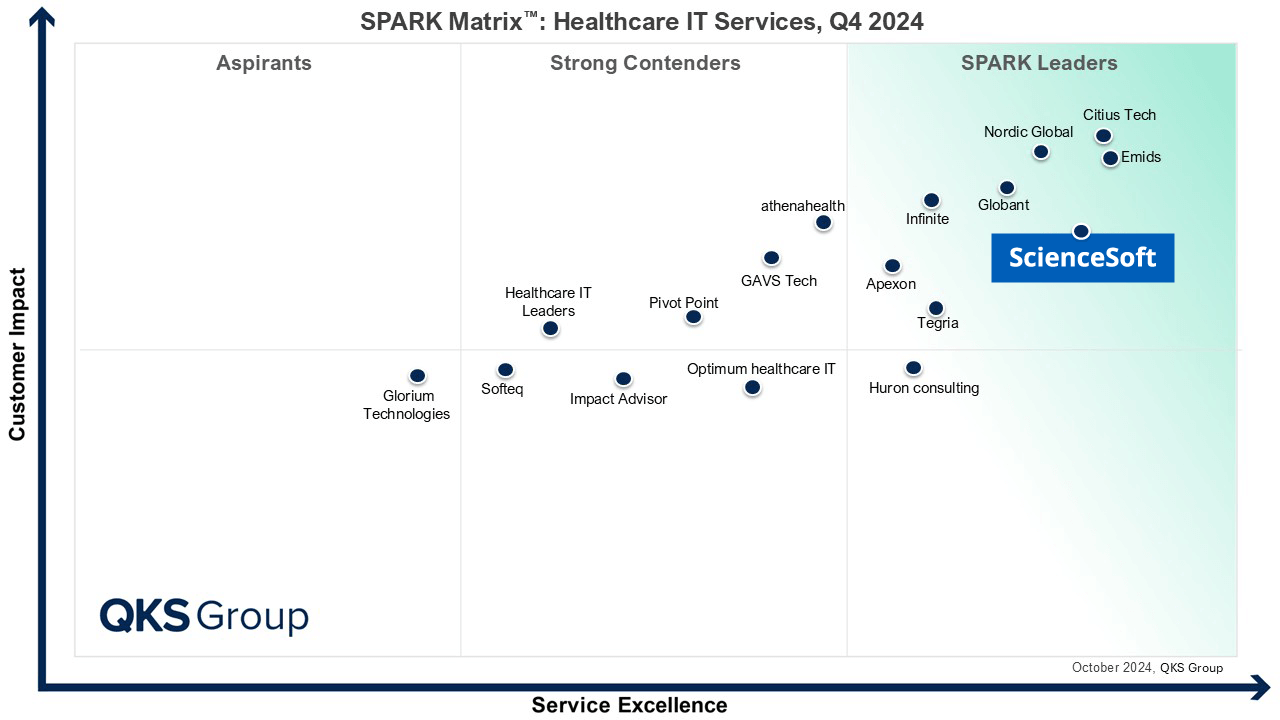How to Build an EHR System
Guide by an ISO 13485-Certified Software Development Company
Drawing on 19 years of experience in healthcare IT, ScienceSoft builds user-friendly EHR software products and custom EHR systems that are loved by physicians and nurses worldwide.
Key Aspects of Building EHR Software
A baseline EHR system should cover secure PHI storage, billing, health records management, and treatment planning. To boost medical staff productivity, EHR apps may be expanded with clinical decision support (CDS) capabilities and AI-powered convenience features, such as dictation and image recognition for quick document scanning.
How to create EHR software in 8 steps
- Conduct market analysis and needs assessment, conceptualize your EHR, set up a business case.
- Create SRS, design architecture and integrations with healthcare systems, select techs.
- Plan timeframes, milestones, KPIs, budget, ONC certification, and risk mitigation.
- Develop intuitive UX/UI for staff and patients, gather feedback.
- Build the EHR in sprints, implement API integrations and security features, test the solution.
- Perform compliance audits and obtain certifications.
- Deploy, execute marketing or rollout and adoption strategies, train staff on usage.
- Provide ongoing support and updates, measure user satisfaction.
At ScienceSoft, we understand our clients want to get fast ROI from their EHR initiatives, so we deliver the first working software version in 2–4 months. The cost of a full-fledged EHR system built from scratch may vary from $400,000 to $2,000,000, depending on the software's complexity. Use our free calculator to gauge expenses tailored to your project.
Advanced EHR Software in High Demand
Sample EHR Development Plan
Below, ScienceSoft’s consultants describe a generalized plan for EHR software development. When working with clients, our team adjusts these steps to fit the needs of each unique project, including target market regulations, medical specialty specifics (e.g., EHR for mental health), and more.
1.
Discovery stage
For software product companies
- Analyzing the market of EHR products, identifying the competitors, and defining target customers and their needs.
- Shaping an EHR concept, including competitive features like CDS modules, medical specialty features, AI capabilities, and more.
- Creating a marketing strategy to promote the EHR product to hospitals, health networks, private practices, etc.
- Planning the monetization approach and service options (e.g., subscription plans with access to basic or advanced EHR feature packs).
- Identifying applicable EHR compliance requirements (e.g., HIPAA, GDPR, ONC, FDA).
- Developing a business case with TCO and ROI calculations.
For healthcare providers
- Analyzing the current care and billing operations to determine the business needs to be addressed with a new EHR.
- Collecting user feedback on the current health records system.
- Creating an EHR concept reflecting the needs of medical and administrative staff.
- Developing the EHR adoption strategy.
- Planning data migration from the former health records system.
- Identifying applicable EHR compliance requirements (e.g., HIPAA, GDPR, ONC, FDA).
- Developing a business case with TCO and ROI calculations.
If you build an EHR for US users and engage an outsourced team, you need to sign a Business Associate Agreement (BAA) with the vendor. According to HIPAA, this contract is a must for all parties that have access to PHI, as it guarantees proper data handling.
2.
Requirements engineering, architecture, and integrations design
- Defining functional and non-functional EHR requirements to create a software requirements specification.
- Designing a secure-by-design and flexible EHR architecture (e.g., microservices-based).
- Designing APIs to smoothly integrate EHR with popular healthcare software products or internal systems (clearinghouse software, laboratory information system, medical imaging software, and more).
- Selecting a suitable tech stack (e.g., HIPAA-compliant hosting, cost-efficient and secure cloud components for scalable data storage).
- Mapping the EHR usage risks and developing a risk mitigation plan.
3.
Project planning
- Selecting an approach to project management (Scrum, Kanban, etc.).
- Planning the project team, timeframes, key milestones, KPIs, and budget.
- Planning the ONC certification process (US only) or certification according to the requirements of other local authorities.
- Creating a risk assessment and mitigation plan for EHR development (e.g., certification delays, scope creep).
4.
UX and UI design
- Conducting UX research to define user scenarios for all user roles (e.g., physicians, nurses, administrative staff).
- Designing UX wireframes and testing the UX.
- Creating UI prototypes for the EHR using the wireframes.
According to KLAS researchers, high EHR satisfaction rates increase the chances of physicians staying with their current employer by 5x. I recommend focusing on user convenience and easy navigation when designing the UX of the EHR. If you’re developing an EHR for your healthcare organization, you may engage your staff members (physicians, nurses, administrators) to review the UI prototypes, spot the pain points, and remove potential issues early. If you represent a software product company, we have MD consultants on board to check the UI from the target audience's point of view.
5.
Iterative development and testing
- Developing back end and front end in 2–4-week iterations.
- Creating APIs for EHR integration with medical software or smart medical devices.
- Implementing security features for PHI protection (e.g., role-based access, data encryption, MFA).
- Testing the EHR (including functional, integration, performance, security, compliance, compatibility, and accessibility testing).
6.
Pre-launch
- Updating the EHR usage risks matrix and project documentation to make sure all changes are reflected for future certification, support, and updates.
- Conducting a HIPAA compliance pre-audit or GDPR compliance audit.
- Submitting the EHR to the ONC-Authorized Testing Laboratory (for the US) or other local EHR certification bodies.
- If the EHR features SaMD capabilities: submitting the software for premarket approval according to the FDA 501k program (US) or MDR requirements (EU).
- Creating and publishing quick start guides for physicians, nurses, and other user groups.
- For healthcare organizations: migrating healthcare data from the legacy systems.
7.
EHR launch
- EHR software deployment to the chosen environment and EHR launch.
- For product companies: executing the marketing strategy to gain customers (e.g., utilizing online channels and industry conferences to promote the software, establishing interoperability with other popular medical software products).
- For healthcare organizations: executing the EHR rollout and adoption strategy; training medical staff on the software use.
8.
Support, maintenance, and evolution
- Launching a help desk to handle questions and issues reported by the EHR users.
- Monitoring user satisfaction and maintaining the EHR by fixing defects, resolving incidents, adding security patches to ensure compliance, and more.
- Upgrading EHR functionality based on the user feedback.
ScienceSoft as Your Partner in EHR Development
- 35 years in IT and 19 years in the healthcare industry.
- PHI safety backed by 21 years in cybersecurity.
- Compliance with HIPAA, HITECH, ONC, GDPR, MDR, MACRA, MIPS, CEHRT, NCPDP, and SAFER.
- 150+ successful healthcare IT projects.
- Working experience with healthcare data exchange standards like HL7, FHIR, DICOM, ICD-10, CPT, XDS/XDS-I.
- ISO 13485 certification to develop SaMD and healthcare software following the requirements of the FDA and Council of the European Union.
- ISO 9001 and ISO 27001 certifications proving our commitment to software quality and security.
- Established Lean, Agile, and DevOps cultures to ensure fast and efficient EHR development.
What makes ScienceSoft different
Driving success in healthcare IT projects no matter what
ScienceSoft develops healthcare IT solutions that reduce care delivery costs and improve outcomes, no matter the challenges posed by diverse expectations of medical staff, shifting priorities, and resistance to change.
Our Awards and Recognitions

Listed among Healthcare IT Service Leaders in 2022 and 2024
Growing faster than Amazon, Google, and ServiceNow
Recognized for reliability and trustworthiness
Recognized by Health Tech Newspaper awards for the third time

Top Healthcare IT Developer and Advisor by Black Book™ survey 2023
Best in class in medical device connectivity (2023)
A top outsourcing provider for three consecutive years
ISO 13485-certified quality management system
ISO 27001-certified security management system
Discover Our EHR and HIE Projects
9 results for:

Redesign of a Custom EHR Application for a US Chiropractic Care Provider
As a result of the code review for a US local chiropractic care provider, ScienceSoft detected serious vulnerabilities in the client's EHR application. Our team provided business consulting and full software redesign to enhance security and user experience.

Development of an EHR Mobile Version for a US Healthcare Provider
ScienceSoft created a hospital mobile app for nurses and physicians to facilitate their work with inpatients.

PHI De-Identification and Sharing Software for Gulf-Based HIE Provider
ScienceSoft has augmented the client's software development team to help deliver a data de-identification and sharing module for an HIE platform.

BI Solution for a US Leading HIE Vendor
ScienceSoft delivered a BI solution that facilitates health issues management. The system enables health issues segmentation, demographics data exploration, and issue probability and prevention analysis.

Incident Management Software to Reduce Accidents in Assisted Livings
ScienceSoft created the risk management module for care team members with notification and investigation submodules to protocol and inquire the incidents related to medications, residents, environment, and staff.
Take the Next Step Toward EHR Excellence
When you partner with ScienceSoft on EHR development, you get access to decades-long expertise in healthcare IT, PHI privacy, security, project management, data science, AI, blockchain, and more. Our top priority is driving project success no matter what while keeping to the agreed time and budget and responding to uncertainties agilely.
Typical Roles on ScienceSoft’s EHR Development Teams
ScienceSoft composes the project team only after carefully studying your requirements for the future electronic medical record system. We don't try to upsell the talents you won't need — you get only high-performing specialists with clear responsibilities.
Project manager
Handles project and budget planning, manages the team and distributes the tasks, monitors project health, and communicates with stakeholders.
Healthcare IT consultant
Analyzes the stakeholders' needs and designs the EHR requirements. Plans the market entry or EHR adoption strategy, defines required software integrations, and more.
Solution architect
Composes a tech stack for the future EHR system and designs a secure architecture and APIs according to regulatory requirements.
Regulatory compliance expert
Ensures EHR compliance with the applicable regulations, helps assess the risks and create software documentation, assists in EHR certification and compliance audits.
UX designer
Creates user scenarios based on UX research; designs tailored UX prototypes for medical and administrative staff.
UI designer
Turns UX prototypes into a convenient EHR interface with branded design elements.
Back-end developer
Develops the EHR business logic, the server side, and APIs for EHR integration with other healthcare systems.
Front-end developer
Creates the user side of EHR software following the UI design.
DevOps engineer
Establishes the EHR development infrastructure, sets up a CI/CD pipeline for deployment automation, and monitors the EHR’s health post-launch.
QA engineer
Designs an EHR testing strategy and test cases, tests the EHR, reports on the identified issues, and validates bug fixes.
Security engineer
Verifies the security of EHR architecture design and coding practices, conducts EHR vulnerability assessment and penetration testing.
EHR Project Sourcing Models: Pros and Cons
Technologies We Use to Deliver an Advanced EHR
Costs of Building an EHR
Key EHR development cost factors
- The EHR scope: general and medical specialty features, including advanced functionality like voice recognition, RPM, AI chatbots, or blockchain-based PHI storage.
- The number and complexity of EHR integrations, including APIs for custom and off-the-shelf software, medical devices, etc.
- The expected number of software users (medical and administrative staff).
- The chosen technology stack, EHR architecture, and expected data storage volume.
- The costs associated with compliance and EHR certification.
- The project management approach, sourcing model, and team composition.
- Infrastructure, maintenance, and support costs.
- For SaaS product companies: the expected number of EHR software tenants (hospitals, private practices, etc.).
Based on ScienceSoft's experience, building an EHR system may cost from $400,000 to $2,000,000, depending on the software specifics, target user base, and the presence of advanced features. Learn more about EHR implementation cost factors and ROI.
Get to Know the Cost of Your EHR Development Project
Please answer a few quick questions about your EHR requirements to help our healthcare IT consultants calculate your solution cost faster.
Thank you for your request!
We will analyze your case and get back to you within a business day to share a ballpark estimate.
In the meantime, would you like to learn more about ScienceSoft?
- Project success no matter what: learn how we make good on our mission.
- 19 years in healthcare IT services: check what we do.
- 4,000 successful projects: explore our portfolio.
- 1,300+ incredible clients: read what they say.

About ScienceSoft
ScienceSoft is an IT consulting and software development company with 35 years in IT. With 150+ successful healthcare IT projects behind our belts, we are here to build electronic health record software with advanced diagnostic and convenience features.




